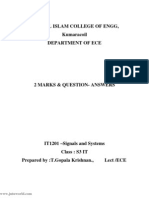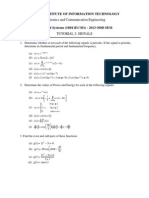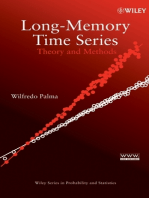EEB731 Signals and Systems: Tutorial 2 Q1
Uploaded by
Prince RaynalEEB731 Signals and Systems: Tutorial 2 Q1
Uploaded by
Prince RaynalEEB731
Signals and Systems
Tutorial 2
Q1. Consider a signal
( ) {
Plot the following transformed signals:
a) y(t ) = x(2 − t )
b) y(t ) = x(1 − 2t )
c) y(t ) = x(2t + 1)
d) y(t ) = x(3t + 3)
e) y(t ) = x(2t − 3)
Q2. a) What is the total energy of the rectangular pulse shown below.
b) What is the average power of the square wave shown below.
Q3. The discrete-time signal x[n] is defined by
{
| |
Find the composite signal y[n] defined in terms of x[n] by
y[n] = x[n] + x[-n]
Q4. The discrete-time signal x[n] is defined by
{
| |
Find the time-shifted signal y[n] = x[n+3]
Q5. a) Consider the rectangular pulse x(t) as shown below. This pulse has an amplitude
of A and duration of T. Express x(t) as a weighted sum of two step functions.
b) A discrete-time signal x[n] is defined by
Using u[n], describe x[n] as the superposition of two step functions.
Q6. Evaluate the following integrals:
4
a). I 1 = ∫ t sin(t / 2)δ (π − t ) dt
0
2
b). I 1 = ∫ t sin(t / 2)δ (π − t ) dt
0
2
c). I 1 = ∫ (t 2 + 2)δ (2t − 3) dt
−1
Q7. Express the operator that describes the input-output relation
( )
in terms of the time-shift operator S. Also develop a block diagram representation
for it.
You might also like
- Signals and Systems - Weekly Test 02 Discussion Notes - Shreshth GATE 2025 Electrical Weekend (Hinglish)No ratings yetSignals and Systems - Weekly Test 02 Discussion Notes - Shreshth GATE 2025 Electrical Weekend (Hinglish)16 pages
- 6426cb56a47f760018386b4c ## LTI System & CTFS Practice SheetNo ratings yet6426cb56a47f760018386b4c ## LTI System & CTFS Practice Sheet6 pages
- Department of Communications, SENSE, VIT Vellore Signals and Systems Assignment-1 (Due Date: 03/08/2018)No ratings yetDepartment of Communications, SENSE, VIT Vellore Signals and Systems Assignment-1 (Due Date: 03/08/2018)2 pages
- (T) and The Output y (T) I (T) in The Form Of: (1) Differential Equation (2) Transfer FunctionNo ratings yet(T) and The Output y (T) I (T) in The Form Of: (1) Differential Equation (2) Transfer Function3 pages
- Jaypee University of Engineering & Technology: Signals and Systems (18B11EC312) Tutorial Sheet - 1No ratings yetJaypee University of Engineering & Technology: Signals and Systems (18B11EC312) Tutorial Sheet - 11 page
- Introduction to Signals & Systems _ Practice Sheet 01No ratings yetIntroduction to Signals & Systems _ Practice Sheet 016 pages
- 1070uf 06-12-24 Ee Ec SignalsystemssolutionsNo ratings yet1070uf 06-12-24 Ee Ec Signalsystemssolutions19 pages
- Basic Signals and Signal Operation Lec2No ratings yetBasic Signals and Signal Operation Lec218 pages
- Student Solutions Manual to Accompany Economic Dynamics in Discrete Time, secondeditionFrom EverandStudent Solutions Manual to Accompany Economic Dynamics in Discrete Time, secondedition4.5/5 (2)
- Analytic Geometry: Graphic Solutions Using Matlab LanguageFrom EverandAnalytic Geometry: Graphic Solutions Using Matlab LanguageNo ratings yet
- Lecture 7.0: Continuous Time Systems Cont.. Properties of LTI System Memory Less LTI SystemNo ratings yetLecture 7.0: Continuous Time Systems Cont.. Properties of LTI System Memory Less LTI System6 pages

































































